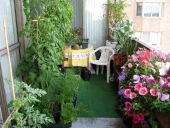


















 1
1





Take your yard beyond lawn, and farm further http://abundantdesign.com/

 1
1





Clay is awesome.Belinda Pepper wrote: there was a lot of clay
what you need is real mineral soil.Belinda Pepper wrote: the beds were filled with fully-aged mixed compost and a little vermiculite

Belinda Pepper wrote: I TRIED to raise some organic seeds I bought, but it's been a lousy failure so far





Jeff Reiland wrote:Very tidy looking garden! I'm also new, have poked around on Permies before but this is my first post

The marigolds are good, any flowers that attract predators are good. You could try the "tea" method you referenced or even a mild soap solution that will suffocate them. Just be careful of overdoing it and hitting any beneficial insects. If you've got a vacuum with a long cord you could suck them up before they fly away. I've heard a reflective (foil) mulch should help, I just have never tried it, don't think it would be very natural/attractive.
I don't know what the other bug is you pictured, just watch for feeding damage until you find out. Good luck!

Leila Rich wrote:Welcome to permies Belinda

Growing plants can be quite a technical business!
Here's a few things that have helped me out...
Mulch: it is absolutely vital in a dry climate. Dried out lawn clippings, commercial pea straw. Get some on there now!
Leila Rich wrote:Clay:
Clay is awesome.Belinda Pepper wrote: there was a lot of clay
I live on pure sand, and while I agree that if clay's unloved it sets like concrete or turns to mud;
it holds water and nutrients like nothing else if you add organic matter like compost, used coffee grounds, aged manure...
When I work with sand, I don't dig much. With unamended clay, I'd fork it over fairly deeply, tipping compost into the gaps left by digging.
Soil:what you need is real mineral soil.Belinda Pepper wrote: the beds were filled with fully-aged mixed compost and a little vermiculite
Compost and vericulite aren't it. That clay though...
 There's still some room in the beds for a little top-dressing, is it too late to add some more of the clay-based dirt I dug out for the pavers?
There's still some room in the beds for a little top-dressing, is it too late to add some more of the clay-based dirt I dug out for the pavers?
Leila Rich wrote:
Water: I'm extremely wary about raised beds outside cold, wet climates. My raised bed frames are great for stopping mulch blowing away though...
 I've got a lot more beds that I want to put in (more room for veggies, and I want to plant some fruit trees & comfrey). I'll try to amend the existing soil there!
I've got a lot more beds that I want to put in (more room for veggies, and I want to plant some fruit trees & comfrey). I'll try to amend the existing soil there!
Leila Rich wrote:Seeds:
Belinda Pepper wrote: I TRIED to raise some organic seeds I bought, but it's been a lousy failure so far
I suggest starting plants from seed when you're feeling more comfortable with growing stuff,
although there's lots of things I'd try direct-seeding now like zucchini, calendula, lettuce, cosmos, sunflower...
It's important with seed-sowing to only cover them with an equal depth of soil to their size.
Most seeds are buried so deeply they don't have the energy to surface.

Leila Rich wrote:So...
It can take at least a couple of years for everything to find a balance. When I started gardening, I had all sorts of sap-sucking insects show up,
as everything was 'out of whack'.
Here's my edited suggestions: next season, fork the native clay through the compost mix, adding loads more organic matter, mulch again.
If you like broad beans, they're a great plant to direct seed in the autumn, that produce in late spring.
They're unlikely to fix nitrogen unless they're inoculated, but that's another story
 I'll get there! I've got some comfrey growing too, which will hopefully be some good mulching/compost for the beds.
I'll get there! I've got some comfrey growing too, which will hopefully be some good mulching/compost for the beds.
Leila Rich wrote:PS, the beetle looks like a weevil







Leila Rich wrote:
It can take at least a couple of years for everything to find a balance. When I started gardening, I had all sorts of sap-sucking insects show up,
as everything was 'out of whack'.
Works at a residential alternative high school in the Himalayas SECMOL.org . "Back home" is Cape Cod, E Coast USA.

|
What kind of corn soldier are you? And don't say "kernel" - that's only for this tiny ad:
Learn Permaculture through a little hard work
https://wheaton-labs.com/bootcamp
|






